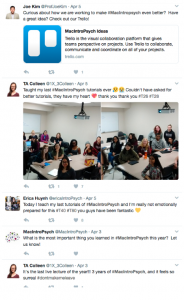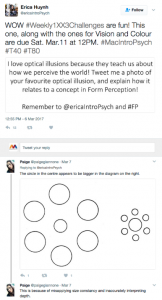Social Media in the Classroom: One Hashtag to Unity
By Biljana Njegovan
April 10, 2018
Social Media has been a part of our private lives for roughly a decade now. While the casual use of these tools has been wide spread for many years, the use of social media in higher education is a newer trend. A 2017 PEW Research study showed that 90% of Canadian’s aged 18-34 use social media. Considering that almost all university-aged Canadians use social media to some extent; integrating social media into teaching and learning is a logical progression. There are many tools are our disposal and it can be difficult to determine the right tool for the right learning outcome. Over the next few months we’ll look at examples of social media use in education and we’ll pay particular attention to examples at McMaster University.
In this first post, we’ll take at how social media can be used to create a sense of community. Creating a sense of community can be difficult in a large introductory course. It’s easy for students to feel lost in the crowd, even when the class has been divided into smaller sections and tutorial groups. How do you create a strong sense of community in a large introductory course with 2,500 students spread over two campuses? For Professor Joe Kim, the answer is Twitter. Joe Kim wanted to personally connect with his students and to encourage regular communication between students and their TAs. So, he set up a class Twitter account (@MacIntroPsych) and the course hashtag #MacIntroPsych.” Joe had a desire to personally connect with his students to establish a strong community. We sat down with Joe to learn more about #MacIntroPsych.
When did you start incorporating Twitter in Intro Psych?
I began to experiment with Twitter and to incorporate it into the course in the last year. I took it a lot more seriously this year integrating and my goals were to connect the class and build community. It’s a gigantic course; we have 2400 students here and 150 at Conestoga. The students are in separate lecture sections and then smaller tutorials. I wanted the course to have a feeling of community.
How exactly are you using Twitter?
I tweet out of my account @ProfJoeKim and TAs will also tweet out of their own accounts. We also have a course Twitter account @MacIntroPsych. We all use the hashtag #MacIntroPsych to keep everyone connected and to make it easy for students to follow along. One thing that we do with our Twitter is include regular weekly features. I try to show behind the scenes insider information on whats going on in the course. For example, every week I meet with the TAs and we go over next weeks tutorials together. The TAs and I will tweet to preview the content for the following week, sometimes this includes a song. The TAs are really clever and some of these songs have been really well done. That’s one of the reasons the tutorials are so well run in our course – we intentionally work at building the community.
Another way that I will use Twitter in IntroPsych is for sharing interesting articles with the class. If I read something interesting that the students may find useful I will share that. We have regular class challenges that involve the sections and the TAs and the class Twitter hashtag has become a place where some of that happens. I ran a course wide meme contest for quiz review practice. Students had to come up with a meme that illustrated one of the concepts for the test, and it ended up being quite was popular and a lot of fun. Whichever one got the most likes on Twitter, I delivered a pizza to their tutorial. I dropped by with a pizza and the students were like ‘omg i cant believe this’. I think they love stuff like that. It gives a fun touch to the course, and they feel like they’re part of a community. If like their post or mention them (on Twitter) they come up to me and say “That made my day when you mentioned me in a tweet!” At Conestoga I went there and gave a lecture and delivered pizza – the students went crazy. They couldn’t believe that I was there. They were posting pictures on Twitter. They were so proud. I’ve been really happy with the experiment.
Why did you decide to start using Twitter in this way?
I saw all of this potential with it. I look back at our hashtag #MacIntroPsych as almost a record of things that happened in the course. For example – for Halloween the students voted on a costume for me to wear. It was so funny. After the lecture I probably had 30/40 students asking for a selfie with me – for each of the class sections. I might have taken 200 selfie pictures with students. Things like this turn the class into an event. At the beginning of class as students are coming in I have something like highlights from #MacIntroPsych playing on a slideshow. As they are coming in to the class it is something interesting for them to read. I will also include an abstract and announcements. It’s sort of like a movie theater when you come in. When students see their tweet up there they get very excited. I will look at the activity we’ve had with the class hashtag and from that I will pick the ten most interest tweets and put them in the intro feed and that creates the atmosphere and excitement.
Has incorporating Twitter into the class added a lot of extra work for you?
Not really. I consume a lot of information and media and Twitter great outlet for me. I’m always collecting information. I have a Trello board for this course that I use to keep organized and sometimes when I find interesting things to tweet I will organize them there. I don’t go out of my way to do research just to tweet. It comes naturally.
Do you have any advice for others who may want to add Twitter to their teaching?
Make sure there is a focus for the Twitter account. I have a description of what I tweet and its almost like a brand. I don’t tweet about Donald Trump, for example, I try to focus on my message. I think of myself as a curator of information and so I don’t just share random things. That’s how you steadily grow followers. The other thing is being really consistent. I typically do a tweet a day. If I have nothing to tweet – I won’t tweet. I’m very picky who I follow. I try to put out quality over quantity. I think about what I write, and I find it an interesting challenge to get it to 140 characters and still be interesting and humorous.
What’s next?
One of the things I’ve been experimenting in class with is LiveSlide. That is a presentation software that allows you to embed live polls. I can ask a question and students can text messages and it shows up live on the slide. I think you can integrate it with Twitter so that it shows up live as students tweet. It’s so interesting, I’ve done it a few times at the start of class. I’ll ask a question like, “What’s the most interesting thing you’ve learned in the course so far?” and students write all sorts of interesting things. Students see what they wrote and they laugh – its fun. Another thing I’m looking into is trying a plugin within Powerpoint that tweets automatically – if I get to a point where I’m talking about a certain study, for example, the plugin will automatically tweet the paper I’m talking about while I’m giving the lecture. These are things I might do in the future. I’ll often say “Oh, I’ll tweet that paper” and sometimes I will forget to do that. Having this standardized would be pretty cool.
Click here to continue to our next Social Media in the classroom feature with Liam Stockdale and his Globalization course. We also have a post listing some popular Twitter tools and add-ons.



